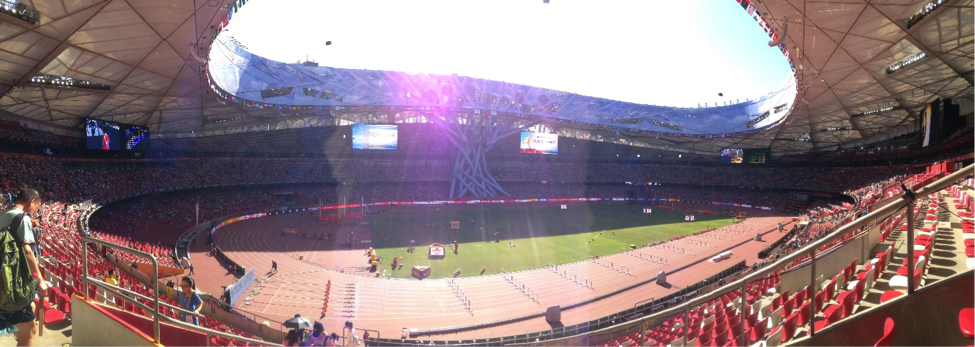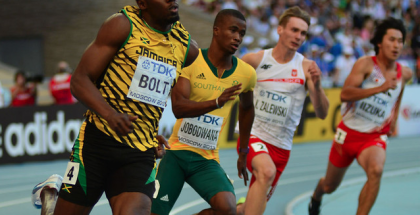From the Stands: Beijing World Championships
Ben Enowitz | On 04, Sep 2015
Although it was work that brought me to Beijing, I still found a way to experience the World Championships, both from inside and outside the Bird’s Nest. I was not able to attend most of the sessions, but the full-access TV coverage allowed for me to stay up-to-date and proved to be an excellent viewing experience (even for a non-Mandarin speaker). With that backdrop, I want to highlight 15 observations from the 2015 Championships:
1. Promotion: It was very evident that there was a big athletic event going on in Beijing. From the moment you walked into the Beijing airport, drove around on the ring roads (the various highways encircling Beijing), and turned on CCTV-5 (the sports channel within China Central Television’s family of networks), it was clear that event organizers were doing their part to promote this event. Signage, banners, and TV advertisements were everywhere and mostly in English. That being said, most of the local Beijingers I spoke to had no idea that a track event was going on (In fact, there was a major dress rehearsal for a military parade during the first weekend of the Championships that more people mentioned). This lack of awareness was most evident in the crowds alongside the road throughout the men’s marathon, which were significantly smaller than anything you would see in a major marathon in the U.S.
2. Sell outs?: Despite reports in July that many of the sessions had yet to sell out, when I went to buy my tickets online during the first week of August, only the opening morning session had tickets available at any price level. Perhaps the prices were too low. For 100 RMB (~USD$15), I sat at the start line on the homestretch with a great view of the shot put, water pit for the steeple, and all the other track events going on that day.
3. Remarkable stadium: Despite hot temperatures, almost the entire stands were covered and provided a nice, shaded viewing experience. The Olympics were 7 years ago, but the stadium looked brand new and was very clean. Video boards were everywhere and always displayed instant replays or relevant stats. It is a truly magnificent stadium, with its scale and design matching the feel and character of the city of Beijing.
4. Organizational issues: Getting physical tickets was a bit of a nightmare. There was no e-delivery of tickets bought online, so you had to go to a physical stand at the stadium to get your ticket printed based on your order number. Most box office stands seemed to have broken printers so a small group of us were sent from box office to box office until we finally found a working printer. Some of the technology in the stadium was fantastic and at other times, I was left scratching my head not understanding the inconsistency.
5. In-stadium atmosphere: The in-stadium atmosphere was hit and miss. The video coverage on the big board was fantastic, the music was well-timed (and surprisingly mostly Western), but the fan-base was rarely over-the-top loud or excited. Despite crowds of 40-50k, the stadium felt empty at times. In addition, many of the morning sessions looked empty on TV despite being technically “sold-out”. Most of all, it was a very quiet atmosphere. Athletes who were not big names or Chinese locals barely received a sympathy clap during their introductions. Big marks or moves were barely noticed. That being said, the roar when the men’s marathon athletes approached the stadium and entered the track gave me goosebumps.
6. Marathon + a little extra: None of the men’s marathoners seemed to know where the finish-line was inside the stadium. Whereas normally athletes run a lap around the track, the course in Beijing just involved the homestretch of the track. There was no real indication of the finish-line which led to many of the athletes continuing past the finish line and making it halfway around the curve before hitting a wall of photographers. There was even a pair of athletes that ran 200 extra meters…ouch. Other than that, the marathon coverage was fantastic. One very cool aspect about the men’s marathon was watching the video coverage on one of the big video boards inside the stadium. You could watch the live track action, but also see what was going on in the marathon with splits, video coverage, and audio updates.
7. Very few concessions: There was food, drinks, and gear available at the stadium, but it didn’t seem to be over packed like most other stadiums and events. Pricing was reasonable and lines were short. It was almost eerie to not have hot dogs and merchandise stuffed down your throat while walking around a stadium of that size.
8. Understanding the sport: Some of the nuances of track and field were lost on the crowd. In the high jump and long jump, it was clear that the athletes (and even the in-stadium announcers) were asking the crowd to start a rhythmic clap. At first this just led to loud, uncoordinated applause by the crowd. They then tried to lead / orchestrate the crow by playing the equivalent of a drum base over the stadium speakers. However, this eventually led to a humorous situation where the clap sequence concluded even before the athletes began their approach. The crowd loved it though when the athletes motioned to them to get engaged.
9. Home-field advantage: You hear about it all the time. The local athletes at the Olympics or World Championships receiving large crowd supports. The crowd noise for the Chinese athletes was orders of magnitude higher than the rest of the field. It didn’t matter if the Chinese athletes were winning medals or finishing mid-pack in the marathon. The difference in excitement was even more apparent on television. I don’t understand Mandarin, but the CCTV-5 announcers would raise and increase the tempo of their voice when Chinese athletes were approaching a jump or throw. Whether it was a good or bad performance, it felt as if the announcers were commentating on a world record attempt. The amount of coverage for Su Bingtian (the Chinese sprinter who ran sub-10 and made it to the finals of the 100m dash) or Li Jinzhe (who finished 5th in the men’s long-jump, behind two of his countrymen) was incredible. It included pre-recorded video profiles and interviews, post-event analysis of their events, live interviews after the races, coverage of warm-ups, and post-event reactions. If these guys were not national icons before the World Championships, they certainly became them.
10. Field events reigned supreme: The coverage was fantastic, both inside the stadium and on the local TV channels. This is best evidenced by the men’s long jump final where the television station featured three Chinese athletes throughout the entire event. Every attempt was shown on TV even though the 200m heats were being run at the same time featuring many of the big names in track & field e.g. Bolt, Gatlin, etc.
11. Incredible TV coverage: Every event was shown on TV. I didn’t feel like I missed any major attempts in the field events and almost every track event was show in its entirety. It really felt like track and field was on TV for almost the entire day. Keep in mind that CCTV-5 is by the far the biggest sports channel in China. Even when there weren’t live events, CCTV-5 showed replays, previews, interviews, and recaps throughout the entire day (in the early afternoon before the evening session they sometimes had a soccer or volleyball game, but that was it.). I really enjoyed re-watching the events from the prior nights. Since there were very few TV replays of finishes during the live window, I would often re-watch certain events and be able to see something entirely new (so often I only focus on the leaders that I miss the battle for bronze or how athletes from outside my home country perform). Also, almost zero commercials – and certainly zero commercials that would break up an event such as the 10,000m.
12. A city of runners?: The summer heat and humidity means most of the locals get their runs done early. I was doing most of my runs at 5:30 AM and the local parks were completely packed (both on the weekend and during the week). Most of the locals were walking, but a few were jogging. The walkers / joggers were a much older crowd than I am used to seeing in the U.S. (lots of 65+ which was surprising), but there were hundreds of them exercising along one of the main parks in Beijing in the Chaoyang district.
13. Wangfujing: I stayed part of the time right off Wangfujing which is the big tourist shopping district with a large snack street / market. It feels a bit like a toned down mix between Times Square and Fifth Avenue in New York City. Despite multiple athletic stores, I saw only one track athlete featured — It was a large billboard of Tori Bowie, above the Adidas store (lots of Dwyane Wade posters / gear though). It is interesting that very few of the big sponsors put up billboards during such a big track weekend.
14. Heat and humidity were real: It gets hot and it starts warming up very early in the morning. Add the pollution and it very clearly had an impact on the distance races and in particular, the men’s marathon. The track temperature is deceptively warm given that it is not shaded so the stands are at least 10 degrees cooler.
15. Beijing is a big city: Hotels near the stadium were not overpriced and had significant availability. Even when I was not staying close to the stadium, it was only a 30-40 RMB ride ($5-$6 USD) cab ride and was very easy to get to. I guess when a city has 20 million people, a few thousand coming in for a track event doesn’t really shake things up.





















Submit a Comment